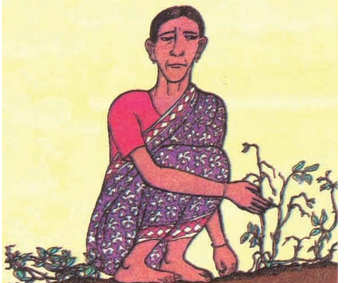Credit
Money And Credit of Class 10
Credit (loan) refers to an agreement in which the lender supplies the borrower with money, goods or services in return for the promise of future payment.
TWO DIFFERENT CREDIT SITUATIONS:
- During the situation of a sudden demand, the producers obtain credit to meet the working capital needs for production. The credit helps him to meet the ongoing expenses of production on time, and thereby increases his earning. Credit therefore plays a vital and positive role in this situation.
- In rural areas the main demand for credit is for crop cultivation. Farmers usually take crop loans at the beginning of the season and repaythe loan after harvest. Repayment of the loan is crucially dependent on the income from farming. The failure of the crop makes the loan repayment impossible. Credit instead helping them in improving their earnings, left those worse off. This is an example of what is commonly called debt-trap. Credit in this case pushes the borrower into a situation from which recovery is very painful.
ROLE OF CREDIT FOR DEVELOPMENT:
- It plays a major role in the development of a country by creating better facilities for agricultural and industrial activities.
- Moreover, it helps people from all walks of life insetting up their business, increase their earnings and support their families.
- To some people, loans help a lot in constructing their houses and get rid of monthly rents.
- To others, loans or credit help a lot in raising their social status by enabling them to buy cars, scooters, televisions etc.
SWAPNA’S PROBLEM:
Swapna, a small farmer, grows groundnut on her three acres of land. She takes a loan from the moneylender to meet the expenses of cultivation, hoping that her harvest would help repay the loan. Midway through the season the crop is hit by pests and the crop fails. Though Swapna sprays her crops with expensive pesticides, it makes little difference. She is unable to repay the moneylender and the debt grows over the year into a large amount. Next year, Swapna takes a fresh loan for cultivation. It is a normal crop this year. But the earnings are not enough to cover the old loan. She is caught in debt. She has to sell a part of the land to pay off the debt.

TERMS OF CREDIT :
Interest rate, collateral and documentation requirement, and the mode of repayment together comprise what is called the terms of credit. The terms of credit vary substantially from one credit arrangement to another. They may vary depending on the nature of the lender and the borrower,
COLLATERAL:
Is an asset that the borrower owns (such as land, building, vehicle, livestock, deposits with banks) and uses this as a guarantee to a lender until the loan is repaid? If the borrower fails to repay the loan, the lender has the right to sell the asset or collateral to obtain payment. Property such as land titles, deposits with banks, livestock are some common examples of collateral used for borrowing.
LOANS FROM COOPERATIVES:
Besides banks, the other major sources of cheap credit in rural areas are the cooperative societies (or cooperatives). Members of a cooperative pool their resources for cooperation in certain areas. There are several types of cooperatives possible such as farmers cooperatives, weavers cooperatives, industrial workers cooperatives, etc. Krishak Cooperative functions in a village not very far away from Sonpur. It has 2300 farmers as members. It accepts deposits from its members. With these depositions as collateral, the Cooperative has obtained a large loan from the bank. These funds are used to provide loans to members. Once these loans are repaid, another round of lending can take place.
Krishak Cooperative provides loans for the purchase of agricultural implements, loans for cultivation and agricultural trade, fishery loans, loans for construction of house and for a variety of other expenses.









